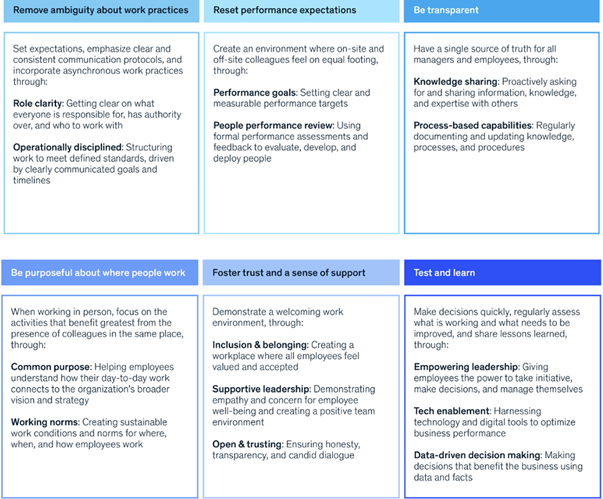Hybrid forms of work characterise the modern working world. But how do they influence productivity, leadership and sustainability? A look at research and practice.
Hybrid forms of work have become an integral part of the modern working world. Flexible working models can increase the productivity and well-being of employees. At the same time, they present companies with new challenges in areas such as leadership, legal frameworks and sustainability. In this article, I take a detailed look at current scientific findings, current areas of tension and practical implementations of hybrid working models.
Current scientific contributions on hybrid forms of work
From the wealth of current contributions, only a few key ones are mentioned below:
Productivity and efficiency: Studies show that hybrid working models not only promote the well-being of employees, but can also significantly increase their productivity. Studies by McKinsey [e.g. July 2023 | February 2024] and new findings by Lynda Gratton show that employees who can work flexibly are often more productive and happier.
However, this is not automatic, but goes hand in hand with an inclusive corporate culture, clear strategies and roles, regular communication and flexible working conditions.
For more information: Study by the Connected Work Innovation Hub project and Marc Effron’s article on existing myths.
Leadership and team dynamics: Hybrid forms of work require new approaches and strategies from managers. The challenge is to effectively lead both remote and on-site team members and to ensure coherent team dynamics. Recent articles, such as those from Haufe and Deloitte, are proof that communication, trust and personal moments play key roles in this.
Employee turnover and commitment: Increased employee satisfaction through flexible working conditions can significantly reduce staff turnover. A recent study by Bloom, Han and Liang concluded, among other things, that hybrid working improves job satisfaction and significantly reduces the churn rate. Furthermore, the results indicate that a hybrid work schedule with two days of working from home per week is not detrimental to performance.
Sitting between the chairs
In the context of hybrid working models, the expression ‘sitting between the chairs’ describes the dilemma that employees and companies often find themselves in. They try to combine the advantages of both worlds, but run the risk of not fully satisfying either side. Here are some aspects in which this area of tension becomes clear:
Leadership and flexibility: the balancing act between control and autonomy
Managers caught between flexibility and control: Managers often find themselves ‘caught between two stools’. On the one hand, they want to support employees’ desire for more flexibility and autonomy. On the other hand, they also recognise the need to maintain control and an overview of team performance. This balancing act can mean that neither the employees’ need for flexibility nor the requirements for leadership and structure are fully met.
Team dynamics between proximity and distance: In hybrid teams, the team dynamic can feel like a ‘seat between the chairs’ when one part of the team is in the office and the other is working remotely. Those working in the office may feel more involved in decisions, while those working remotely may feel isolated or less recognised. This division can lead to tensions and affect team spirit.
Employees between remote and on-site: the balancing act of productivity
Working in the office and working at home: Employees who work in a hybrid environment can feel that they are constantly caught between the expectations of office work and the demands of the home office. This can lead to a situation in which they do not feel completely comfortable or productive in the office or at home.
Separation of work and private life: Hybrid working has different effects on different social groups and lifeworlds. While some employees welcome the flexibility, others feel isolated or disadvantaged. Sociological analyses, such as the Sinus-Milieus, help to understand which groups particularly benefit from hybrid working models – and which do not. Some examples:
- Workforces in the conservative-established milieu may be more sceptical of hybrid forms of work, as they may value the separation between work and private life and prefer the office as a place to work.
- Employees from the middle-class milieu could see hybrid models as an opportunity to better reconcile work and family commitments.
- People from the hedonistic milieu, who value fun and variety, could welcome hybrid forms of work due to their flexibility.
Hybrid working models can make a significant contribution to reducing the carbon footprint. Less commuter traffic, lower energy consumption in offices and optimised use of resources are just some of the environmental benefits. Practical experience from IKEA, Nestlé and Siemens show how significant the contribution of hybrid models can be to sustainability.
However, it is also a fact that the hybrid model blurs the boundaries between work and retreat and not all milieus feel comfortable with it.
Tradition meets innovation: legal and cultural challenges of hybrid work
Companies caught between tradition and innovation: Companies are often faced with the challenge of harmonising traditional working methods and corporate culture with the requirements of the digital and flexible working world. They have to find a middle way that utilises the advantages of both worlds without neglecting either side. This may mean that companies make slower progress in adapting their processes and culture so as not to completely abandon either ‘chair’.
Labour and social law challenges: Legally, too, companies often find themselves caught between two stools when it comes to designing hybrid forms of work that both meet the needs of employees and comply with legal requirements. This is particularly challenging when employees work from abroad or different working time regulations apply to different locations.
The introduction of hybrid working models therefore raises numerous legal questions:
- How does the Working Hours Act apply in the home office?
- Which data protection regulations must be complied with?
- What agreements need to be included in the employment contract?
Working from home also brings with it social law challenges:
- How are employees at home insured?
- What obligations do employers have with regard to occupational health and safety?
Practical reports on hybrid forms of work and sustainability
A considerable number of German companies are among the pioneers in the introduction of hybrid working models. Practical reports and Dax surveys show how they have successfully implemented hybrid models while also promoting sustainable practices.
The introduction of hybrid working models is associated with numerous challenges: From the technical infrastructure to adapting management styles and complying with legal requirements. But how have companies overcome these challenges? Semi-structured interviews with company representatives, which I conducted in person from 19-30 August 2024, brought interesting solutions to light:
Flexible demographic and legal management: adapting to new work realities
Flexible demographic management: Companies such as Bosch and Siemens use customised models to support older employees in the smooth transition to partial retirement or retirement. This includes flexible working hours and the option of working from home at times. In this way, the experience of older employees is retained by the company, while at the same time a gentle reduction in working hours is possible.
Compliance with legal framework conditions: To ensure compliance with labour and social law, companies rely on legally tested instruments. For example, they only allow employees to work abroad under clearly defined conditions that take into account both tax and social security aspects. One example of this is SAP, which offers special regulations for employees who wish to work temporarily from other countries.
Cultural change and leadership: the key to a successful hybrid working environment
Strengthening the corporate culture: To prevent employees from becoming alienated and to preserve the corporate culture, companies invest in regular hybrid team events and training. BASF, for example, uses a mix of online and face-to-face events to maintain employees’ emotional ties to the company and at the same time avoid “social erosion” through regular contact with colleagues as far as possible.
Optimisation of the management culture: managers receive special training to meet the requirements of hybrid working. This includes training in digital leadership, communication and conflict management. Companies such as Siemens rely on a leadership programme that enables managers to effectively manage hybrid teams and promote both proximity to employees and their creativity.
Equality and balance: harmonising work and private life
Equal rights for ‘white collar’ and ‘blue collar’ employees: To ensure that hybrid working models are viable for both ‘white collar’ and ‘blue collar’ employees, companies are developing flexible solutions that cater to both groups. Bosch, for example, offers shift models with variable working hours for production employees, while office workers benefit from flexible home office arrangements.
Promoting the separation of work and private life: Companies such as SAP rely on clear guidelines and technical tools to support the demarcation of work and private life. This includes, for example, the introduction of fixed working hours, digital switch-off options after work and the promotion of conscious breaks during the working day.
Efficient planning and coordination: The coordination of team appointments is optimised through the use of digital tools that make it possible to coordinate meetings and joint working hours efficiently. Tools such as Microsoft Teams or Zoom are already being used by numerous companies to facilitate collaboration in hybrid teams and ensure that all team members remain involved.
Conclusion
With a smart approach, hybrid forms of work not only offer flexibility and higher productivity, but also make a significant contribution to sustainability. In order to fully utilise the potential, companies must observe legal requirements, adopt a socially differentiated approach and adapt their management culture. The practical reports from leading companies show that hybrid working models are forward-looking – if they are implemented strategically and sustainably.
As outlined in the article, there is a considerable need for research in analysing the connection between milieu affiliation, resource and energy consumption and the contradiction between talking and doing. By taking the SINUS milieus into account, companies can ensure that their hybrid working models are inclusive, fair and beneficial for all employees.
Overall, ‘sitting between the chairs’ in the context of hybrid working models illustrates the tensions and compromises that both employees and companies have to make in order to utilise the benefits of hybrid working models without losing sight of the risks and disadvantages.



Leave A Comment